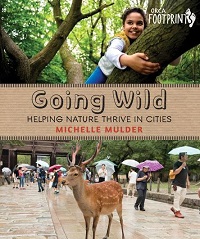| ________________
CM . . . . Volume XXIV Number 22. . . . February 9, 2018
excerpt:
Going Wild joins a growing number of titles on the market about the ‘rewilding’ of urban spaces with the goal to help humans relate more closely with nature. It’s true that city planners now routinely include green space in new communities while rooftop gardens on high rise buildings add aesthetic quality as well as shade and fresh food. Both are done in recognition of health benefits to both people and the environment. In the Introduction, the author shares her personal story of choosing to live in a small city with easy access to both urban and rural amenities. The book will show that even large cities are increasingly making space for nature. The presentation includes four chapters: the first describes how humans historically worked to exclude nature from cities, the second talks about how our cities look and work as a result of that development, the third deals with benefits of including nature, and the final chapter suggests ways to discover existing links with nature and how to promote incorporating it in our daily lives. Sprinkled throughout, “Wild Fact” boxes share tidbits to catch readers’ interest: e.g. how some animals have adapted to city living. Other inserts, “Making Tracks”, are inspired by events in the author’s personal life: e.g. finding edible plants in local parks. A few print and Internet resources are listed, along with a Glossary. An Index will be included in the final copy. The writing is kid friendly in style, with pertinent examples to help the reader relate to the information. For instance, in the historical background chapter, the fact that European settlers in North America moved Indigenous children into residential schools is used to show one way that people became distanced from nature. One problem with many current city environments is illustrated by how the density of buildings, paved streets and parking lots has augmented flooding hazards. To demonstrate the benefits of restoring wild areas, the book tells about wildlife corridors created to help animals safely travel through a busy city while allowing residents to enjoy sightings of them. To foster such closer links with nature, kids are encouraged to explore citizen science activities in their community. All of this content is delivered in small, readable chunks of text using subheadings. It is generously supported by effectively captioned photos (that add lots of extra interesting facts or points to ponder), mainly showing young people. Only one small photo, that found on page 39, is hard to decipher. Kids are all but invisible even though the caption refers to “these kids….at a Dene cultural winter camp.” Young readers will have no trouble finding references they can relate to throughout this book as they examine their own urban lifestyles for the vital connections with nature that are emphasized here. The author sets a fine example by sharing her personal messages about the importance of “making room in our cities for wilderness.” Going Wild could be well used to stimulate discussion on the topic. Highly Recommended. Gillian Richardson is a freelance writer living in BC.
Next Review |
Table of Contents for This Issue
- February 9, 2018. |
